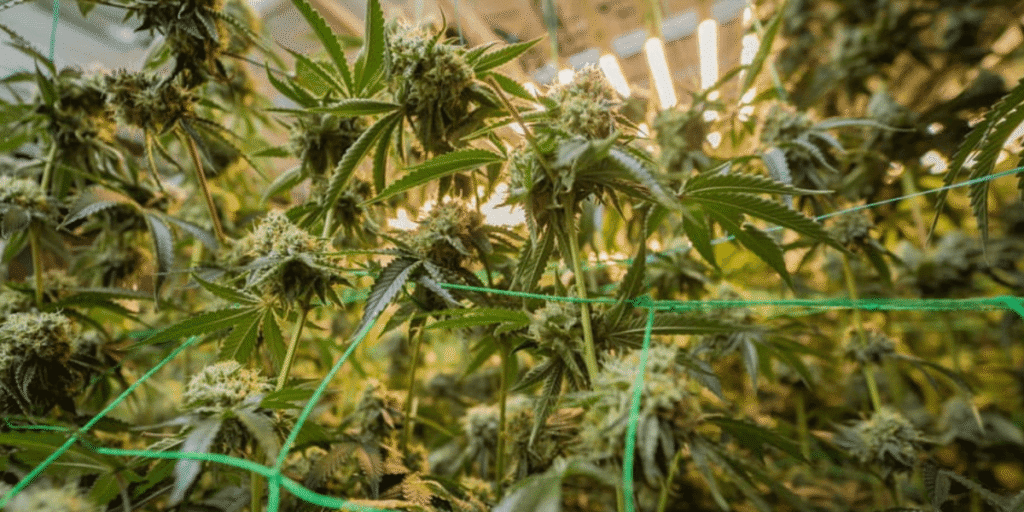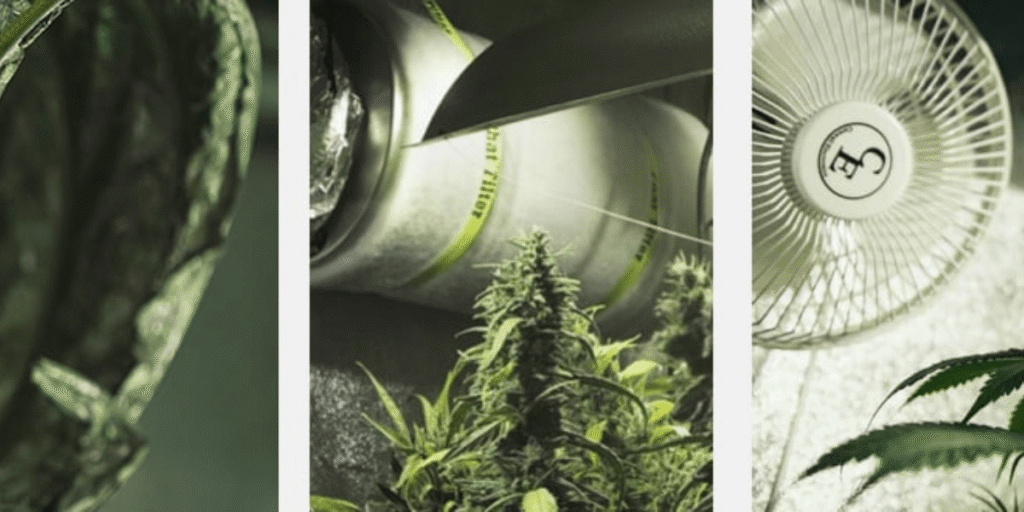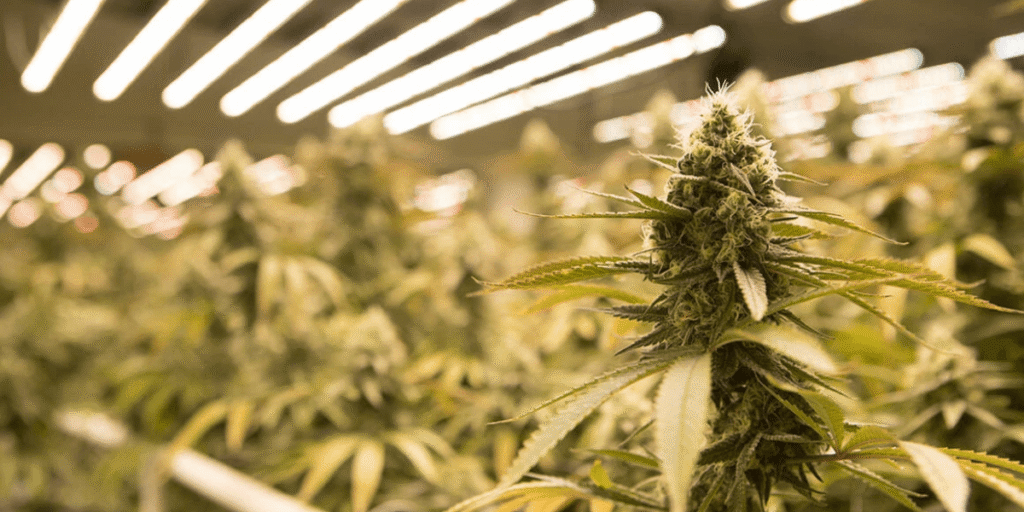Ever wondered if your grow lights are truly giving your cannabis plants what they need? It’s more than just turning them “on” or “off.” Light is a complex spectrum of colors, and understanding how to adjust cannabis light spectrum for different growth stages is one of the most powerful tools a grower can possess.
Think of it like painting with light: each color influences specific plant processes, from photosynthesis and vigorous growth to the very production of those desired cannabinoids and aromatic terpenes. Mastering the light spectrum isn’t just about maximizing yield; it’s about unlocking your plant’s full genetic potential and cultivating truly exceptional cannabis.
The Science Behind the Glow: How Cannabis Light Spectrum Fuels Growth
Before we dive into adjustments, let’s cover the fundamentals.
What Is the Cannabis Light Spectrum and Why Should You Care?
Light is a form of electromagnetic radiation, and the light spectrum refers to the range of wavelengths that make up visible and invisible light. For plants, the most crucial part of this is PAR (Photosynthetically Active Radiation), which encompasses the wavelengths from 400 to 700 nanometers (nm) essentially the colors plants use for photosynthesis. While full-spectrum lights aim to provide all necessary wavelengths, understanding the role of individual colors is key.
How Cannabis Plants Perceive and Respond to Light Spectrum
Plants don’t “see” light the way we do. Instead, they absorb specific wavelengths through specialized pigments and photoreceptors.
- Chlorophyll a and b are the primary pigments responsible for absorbing red and blue light for photosynthesis.
- Other photoreceptors, like phytochromes (sensitive to red/far-red) and cryptochromes (sensitive to blue/UV-A), act as internal clocks and growth regulators, influencing everything from germination to flowering.
The Science of Light Absorption in Cannabis Cultivation
Cannabis plants have distinct absorption peaks, meaning they are most efficient at absorbing light at particular wavelengths. While red and blue light are traditionally seen as the most vital, emerging research highlights the nuanced roles of other wavelengths across the spectrum. And no, green light isn’t useless; it penetrates deeper into the canopy, reaching lower leaves that red and blue light might miss, contributing to overall photosynthesis!
Understanding Light Wavelengths in the Cannabis Spectrum
Each color in the light spectrum plays a unique role in your cannabis plant’s development.
The Role of Blue Light (400–500 nm) in Cannabis Development
- Impact: Promotes strong, compact vegetative growth, helping to reduce stem stretch and produce sturdy plants with thick leaves.
- Ideal for: The seedling and vegetative stages where robust structural development is critical.
How Green Light Affects Cannabis Growth (500–600 nm)
- Impact: While historically overlooked, green light penetrates deeper into the plant canopy than red or blue light. This means it can effectively reach lower leaves, contributing to photosynthesis in dense canopies and influencing stomatal opening.
- Considerations: Too much green light can reduce overall light use efficiency, but a balanced amount is beneficial for deep penetration.
Why Red Light (600–700 nm) Is Essential for Cannabis Flowering
- Impact: Absolutely crucial for efficient photosynthesis, promoting significant stretching during growth, and heavily influencing flowering and bud development.
- Ideal for: The flowering stage, where it drives bud production and expansion.
- Red-to-Far Red Ratio: Balancing red light with far-red light (which we’ll discuss next) is vital for optimal flower initiation, size, and overall plant architecture.
Far-Red Light (700–800 nm): Stretch, Shade Response, and More
- Impact: Though not directly used for photosynthesis, far-red light significantly influences plant stretch, accelerates flowering time, and boosts overall biomass when used in conjunction with red light (known as the “Emerson effect”).
- Use Cases: Can be used to “finish” plants by encouraging a final swell in late flowering or to promote stretching if needed during vegetative growth.
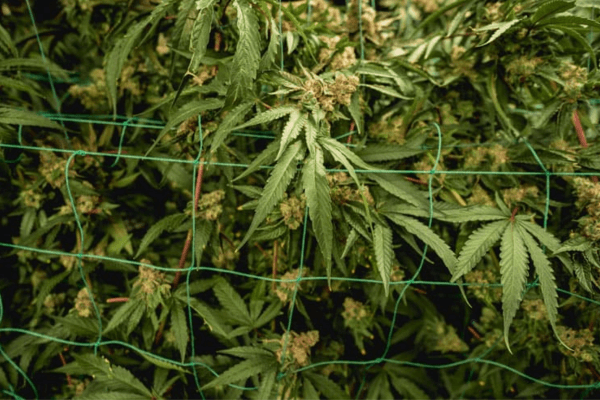
Going Beyond the Visible: UV and IR in the Cannabis Spectrum
Beyond the visible spectrum, ultraviolet and infrared light play specialized roles.
How Ultraviolet Light (UV) Influences Cannabis Cannabinoids
- UVA/UVB/UVC Distinction: While UVC is harmful, UVA and controlled UVB exposure can be beneficial.
- Impact: As a protective response, UV light can stimulate your cannabis plant to produce more THC, CBD, and terpenes, acting as a natural defense mechanism.
- Caution: Too much UV can cause damage to plants (like light burn) and is harmful to humans, requiring proper eye and skin protection during exposure.
Infrared Light and Its Impact on Cannabis Metabolism and Stress
- Impact: Often confused with far-red, infrared light generates heat and, when combined with red light, contributes to the “Emerson effect,” significantly boosting photosynthesis rates. It also promotes stem elongation.
- Caution: Unbalanced or excessive IR can lead to unwanted stretching, especially in the vegetative stage.
How to Adjust Cannabis Light Spectrum for Each Growth Stage
The key to maximizing your cannabis grow is to adjust your light spectrum as your plants progress through their life cycle. For a comprehensive look at the entire cultivation journey, from preparing your seeds to harvesting your bounty, explore our detailed cannabis growing timeline.
Best Spectrum Settings for Cannabis Seedlings and Early Veg
- Focus: Emphasize blue light. This promotes compact, sturdy growth, preventing your young plants from becoming leggy and weak. A higher blue light component helps build a strong foundation.
- Cloning Tip: If you’re starting your grow with clones instead of seeds, understanding light spectrum is just as vital. Learn the step-by-step process to grow cannabis from clones to ensure a strong start.
Late Vegetative Stage: Fine-Tuning Spectrum for Vigorous Growth
- Transition: Introduce a more balanced spectrum with an increasing amount of red light. This prepares the plant for the upcoming flowering phase, encouraging the development of more bud sites and overall biomass.
Flowering Stage Spectrum: Getting Bigger Buds and Better Yields
- Bloom Power: Shift to a high red light content. This is crucial for driving flower production, increasing bud size, and enhancing overall yield. Judicious inclusion of far-red can help with deeper light penetration and final bud swell.
- Potency Push: Introduce controlled amounts of UV light during the late flowering stage (typically the last 2-4 weeks) to stimulate cannabinoid (THC, CBD) and terpene production.
Matching Light Spectrum to Different Cannabis Phenotypes
Remember that different cannabis strains (phenotypes) might react slightly differently to spectrum changes based on their genetics. Observing your specific plants’ responses is always key. If you notice your plants stretching excessively, an increase in blue light could help “correct” this during the vegetative phase.
Optimizing Cannabis Light Spectrum with the Right Equipment
Even the perfect spectrum needs to be delivered correctly.
Types of Grow Lights and Their Cannabis Spectrum Capabilities
- LEDs (Light Emitting Diodes): The most versatile option. Modern LEDs can offer full-spectrum light (mimicking natural sunlight) or tunable spectrum options, allowing you to precisely adjust wavelengths for each growth stage.
- HPS (High-Pressure Sodium): Strong in yellow and red spectrum, making them excellent for the flowering stage but less ideal for vegetative growth due to potential stretching.
- MH (Metal Halide): Rich in blue and green light, making them a good choice for the vegetative stage but less efficient for flowering.
- CMH/LEC (Ceramic Metal Halide/Light Emitting Ceramic): Provide a broad, balanced spectrum similar to natural sunlight, offering good efficiency across all stages.
How to Adjust Light Distance for Maximum Spectrum Efficiency
Beyond spectrum, light intensity and distance are critical.
- DLI (Daily Light Integral): This measures the total amount of PAR light your plants receive over a 24-hour period. It’s a more comprehensive metric than just instantaneous intensity.
- PPFD Maps: Always refer to your light manufacturer’s (or third-party tested) PPFD maps to ensure uniform light distribution across your canopy and to position your lights at the optimal height for the desired intensity at different growth stages.
- Adjusting Height: Raise or lower your lights based on your plants’ response.
- Signs of Too Much Light: Bleaching, yellowing, or “crispy” top leaves (light burn).
- Signs of Too Little Light: Stems stretching excessively, pale leaves, or weak growth.
Balancing Intensity and Spectrum in Your Cannabis Grow Room
This is where light spectrum gets exciting for those chasing quality.
How Cannabis Light Spectrum Affects THC and CBD Production
Specific wavelengths, especially controlled exposure to UVB light, can act as stressors, prompting the cannabis plant to produce more resin, which in turn means higher levels of THC, CBD, and other cannabinoids as a defense mechanism.
Using Spectrum to Maximize Terpene Profiles in Cannabis
Just like cannabinoids, the unique aromatic compounds called terpenes can be enhanced by specific light spectra. UV light, in particular, has been shown to boost terpene profiles, leading to richer aromas, flavors, and potentially contributing to the “entourage effect.”
Light Spectrum’s Role in Enhancing the Entourage Effect
This fascinating concept suggests that cannabinoids and terpenes work synergistically. By optimizing light spectrum to boost both, you can potentially enhance the overall therapeutic and recreational effects of your cannabis.
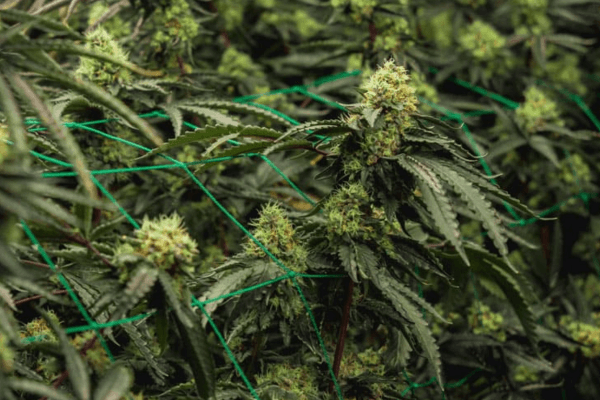
Advanced Techniques to Customize Cannabis Light Spectrum
The world of grow lighting is constantly evolving.
Tunable LED Lights: Precision Control for Cannabis Spectrum
These are game-changers! Tunable spectrum LED lights allow you to precisely adjust the ratios of blue, red, far-red, and even UV light throughout the entire grow cycle. This flexibility allows growers to fine-tune their light strategy for each specific growth stage and even target specific cannabinoid/terpene expressions.
Pulsing Light and Photoperiod Manipulation for Better Results
Advanced techniques, such as manipulating light duration (photoperiod) with precision or even using pulsing light patterns, are being researched to further optimize growth rates, plant morphology, and potentially boost potency.
Synergizing Light Spectrum with CO₂ and Environmental Factors
Remember, light optimization isn’t an isolated factor. It synergizes strongly with other environmental elements like VPD (Vapor Pressure Deficit), CO2 levels, and temperature. For example, higher light intensity (often achieved with optimized spectrum) will demand higher CO2 levels and specific temperature ranges for your plants to photosynthesize at their peak efficiency.
Beyond PPFD: Advanced Metrics to Measure Cannabis Spectrum
While PPFD is a great metric, the industry is also exploring and using other metrics like YPF (Yield Photon Flux) which aims to better represent light useful for biomass. Always review spectral distribution graphs provided by manufacturers to understand the exact output of your light.
FAQs: Your Cannabis Light Spectrum Questions Answered
Got more questions about fine-tuning your grow lights? We’ve got answers!
Q1: Can I use just one type of light spectrum for all growth stages?
A: While technically possible (e.g., with a “full-spectrum” white LED), adjusting the spectrum (more blue for vegetative, more red for flower) will significantly optimize growth, yield, and overall plant health.
Q2: Why are my cannabis plants stretching tall and leggy under my light?
A: Excessive stretching is often a sign of insufficient blue light in your spectrum or your lights being positioned too far from the canopy. Try increasing the blue light component or lowering your light fixture closer to the plants (while monitoring for light stress).
Q3: Does UV light really increase THC/CBD production in cannabis?
A: Yes, controlled exposure to UV light, particularly UVB, can stimulate production as a plant’s protective response, potentially boosting cannabinoids and terpenes.
Q4: What’s the best light spectrum for cannabis seedlings?
A: A higher proportion of blue light (cooler spectrum) is ideal for strong, compact initial growth and preventing stretch.
Q5: Should I use far-red light throughout the entire grow cycle?
A: Far-red is primarily beneficial in the flowering stage to enhance the Emerson effect and promote bud development. Use with caution in veg as it can cause stretch.
Conclusion: Mastering Light Spectrum for Cannabis Success
Understanding and effectively adjusting your cannabis light spectrum for growth stages is paramount for a successful grow. It moves you beyond simply providing light to actively guiding your plant’s development, pushing its genetic boundaries for enhanced yield, potency, and aroma. Experiment, observe your plants’ unique responses, and truly embrace the power of light!
Ready to Grow? Use the Right Cannabis Light Spectrum to Thrive
Feeling more confident about your cannabis vocabulary and light strategy? Awesome! Now it’s time to put that knowledge into practice.
Looking for premium LED grow lights to illuminate your success? Browse our Check out our Grow Light Collection now and find the perfect light to help your plants thrive.
Need personalized guidance for your unique grow space, or help choosing the right grow light or hydro gear? Check out our products at www.greenfuturelight. For expert, one-on-one assistance, contact our team today for a free consultation!
Join Our Growing Community! We absolutely LOVE seeing your setups and successes! Tag us on Instagram: @Greenfuturelight, let’s celebrate your progress together!
A Final Word on Safety: When working with high-intensity grow lights, especially those emitting UV, always wear appropriate eye protection. Your eyes are precious!
Happy growing, friends!

